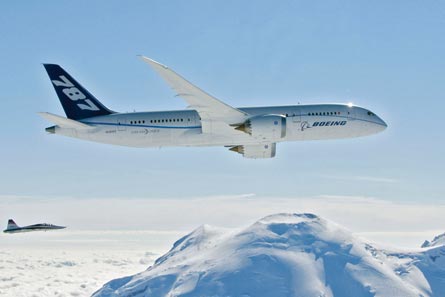With its final configuration for the 787-9 now set, Boeing is to incorporate significant changes in the stretch variant, which include a revised architecture for the carbonfibre horizontal stabiliser. The airframer has also provided more details on the stabiliser production issues that have required inspections of 787s already built.
The 787-9's two 3.1m (120in) fuselage extensions in the Alenia Aeronautica-built Section 46 and Kawasaki Heavy Industries-built Section 43 represent the most significant external change between the 787-8 and larger -9, although Boeing plans a host of internal changes for weight reduction and ease of assembly.
One such change, says Boeing's vice-president of supplier management Bob Noble, is a revised architecture for the horizontal stabiliser on the larger -9.
"As it happens we're going to make a change to the horizontal on the -9," he says, speaking at the Alenia's 787 fuselage manufacturing plant in Grottaglie, Italy. He adds that the revision was always planned for the larger variant, which is due to enter service with Air New Zealand in 2013.
 |
|---|
© Boeing |
An integral multispar box design will be employed on the 787-9 and will result in the spars and skins of the main stabiliser boxes being co-cured together, similar to the aircraft's composite fuselage and co-cured stringers, say programme sources.
The goal is to reduce the amount of parts and workmanship required to assemble the horizontal stabiliser following initial fabrication.
The change in the stabiliser, which is also driven by the different loads expected on the stretched variant, will also result in "a couple hundred pounds" of weight savings, compared with the 787-8.
The new stabiliser design is also being considered for incorporation on the 787-8, although Noble says that decision has not yet been made.
Speaking in Grottaglie, Boeing and its production partner Alenia avoided a formal "mea culpa" for the workmanship issues that have arisen on the horizontal stabiliser of early-build 787s. The airframer insists it is "positively certain" that the same defect will not occur again.
Alenia builds the 787's horizontal stabiliser at its Foggia plant in southern Italy and chief operating officer Daniele Romiti calls the production issue "normal in a manufacturing process".
Noble echoes the sentiment, saying "this is not at all related to the material system, it is not related to the quality system, it is just one of those things that happens during a manufacturing process".
Left unanswered is how the problem went unnoticed by both Boeing and Alenia for 25 shipsets, although Noble says "we know what it is. We're absolutely, positively certain we won't have that same defect again. We have put counter measures in place to assure ourselves of that."
Those countermeasures, says Noble, include a global examination of "all of our joins and make sure the similar thing can't happen anywhere else".
During inspection at its Everett, Washington facility, Boeing discovered shims used to fill gaps in the horizontal stabiliser became compressed after fasteners were over-torqued as a means of pulling the surfaces together, introducing a "pre-load" condition reducing the long-term fatigue life of the structure.
Source: Flight International



















